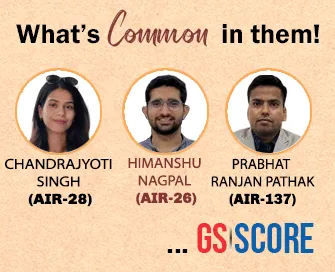


Instruction:
- There will be 2 questions carrying the First Question is-10 marks Write your answers in 150 words and the Second Question is-15 marks Write your answers in 250 words.
- Any page left blank in the answer-book must be crossed out clearly.
- Evaluated Copy will be re-uploaded on the same thread after 2 days of uploading the copy.
- Discussion of the question and one to one answer improvement session of evaluated copies will be conducted through Google Meet with concerned faculty. You will be informed via mail or SMS for the discussion.
Question #1. Universality of Marriage 10 marks (150 words)
Question #2. Incest taboo and proscriptive regulation 15 marks (250 words)
(Examiner will pay special attention to the candidate's grasp of his/her material, its relevance to the subject chosen, and to his/ her ability to think constructively and to present his/her ideas concisely, logically and effectively).
STEPS & INSTRUCTIONS for uploading the answers
Step 1 - The Question for the day is provided below these instructions. It will be available at 7:00 AM.
Step 2 - Uploading of Answers : Write the answer in A4 Sheet leaving proper margins for comments and feedback and upload the PDF in MY ACCOUNT section. Click on the option of SUBMIT COPY to upload the PDF.
Step 3 - Deadline for Uploading Answers: The students shall upload their answers by 7:00 PM in the evening same day. The first 50 copies will be evaluated.
Step 4 - Feedback : Mentors will give their feedback for the answers uploaded. For more personalised feedback, join our telegram channel by clicking on the link https://t.me/mains_answer_writing_cse . A one-to-one session will be conducted with the faculty after copy evaluation in 72 Hrs.
Model Answer
Question #1. Universality of Marriage 10 marks (150 words)
Approach
- Introduce the marriage and explain how marriage is associated with every section of
- Universal Definition of Marriage and examples that relate the marriage has a universal feature that recognized by the needs of the human
- Conclude the topic with a clear justification of universality of marriage.
Hints:
Introduction:
The institution of marriage exists in almost all societies through its customs remain varied. The custom of marriage varies from society to society. The religious communities, castes, and tribes in India present a complex society of rules and customs of marriage.
Universal Definition of Marriage:
- Notes and Queries (1951): Marriage is a union between a man and a woman such that the children born to the woman are recognized as legitimate offspring of both
- Gough’s definition is an improvement on the one given in the Notes and You may also be aware of several cases published in newspapers about caste-based violence on young men and women opting to marry against caste or sub-caste norms. For example- If a Jadav boy wants to marry a Thakur girl, the two would have to face violence at the hands of their respective caste panchayats.
- George Peter Murdock (1949) has defined marriage as a universal institution involving residential co-habitation, economic cooperation, and the nuclear family formation. It is a drawback to the universal definition of marriage. For example- The couples do not live under the same roof in Nayar society.
- Kathleen Gough (1959) in her study of the Nayars has defined marriage as a relationship established between a woman and one or more other persons which provides that a child born to the woman under circumstances not prohibited by the rules of the relationship is accorded full birth-status rights common to normal members of his society. For example- Azande of Sudan in which marriage is based on
- Its universality can be explained through the functions and needs it Edmun Leacd (1955)
has given the following functions of marriage:
- It establishes the legal father/mother of a man’s/woman’s
- It gives control to the husband/wife over the wife’s/husband’s sexual services, labor services, and
- It establishes a joint fund of property for the benefit of the
– It provides for a socially significant relationship between the family/domestic groups of both spouses.
The real need for the existence of marriage in human society is:
- To check the chaos that may result because of sexual competition- In a human being, unlike animals in general, physical dominance and sexual dimorphism are not all that Above all, the human female has the capacity to mate all throughout the year. All these factors can result in fierce sexual competition, which if not curtailed, can lead to chaos. Marriage service is a very important function in regulating institutionalized mating between culturally defined mates.
- To provide for the same stable group or organization that includes a man as well as a woman so that the mother-newborn combination gets proper security- Human babies are not born with fully developed They need perennial protection from the mother, leading to a significant handicap for her as well. This necessitated the association of the mate to take care of both of them. Since females can reproduce till menopause, a permanent binding association was needed. Thus, marriage was created to ensure binding norms.
Conclusion:
Marriage is a universal phenomenon ascribed to and preferred in all human societies. The type of marriage and ways of acquiring a mate varies from society to society. Marriage has a legal sanction to it and the children born of wedlock are always accepted by society. It is the means of achieving economic and social security for the wife and the children.
Through some other alternatives that could have been there to perform all these functions, humans preferred to create the institution of marriage. As all these functions and need have universally recognized in all human groups, marriage has to be a universal feature of human society.
Question #2. Incest taboo and proscriptive regulation 15 marks (250 words)
Approach
- Introduce the Proscriptive marriage
- Explain the norms and local customs with some relevant examples that are associated with the incest
- Conclude the topic that Prohibition is necessity to maintain the social order into
Hints:
Introduction:
Proscriptive rules are those which put a restriction on the selection of mates. These rules forbid men and women from entering into a marital alliance with a certain category of people. Such categorization is done according to the religious norms and local customs.
Incest taboo:
- The incest taboo is a type of proscriptive regulation wherein a marriage between mother-son, father-daughter, and sister-brother is prohibited. It may extend even up to the fifth generation. Incest taboos have been discouraged based on various theories that it leads to inbreeding, leads to disruptions in the family, restricts the formation of wider alliances,
- An exception to incest taboos is those brother-sister marriages in royal families of ancient Egypt and the Hawaiian Anthropologists try to explain the existence of incest taboos based on the following:
- To avoid Inbreeding: It is now widely accepted that the disadvantages of inbreeding definitely outweigh the advantages. People could have possibly known about the deleterious effects of
- Familiarity leads to Avoidance: It has been found in the Israeli kibbutz group and the Taiwanese tradition of raising the daughter-in-law from childhood that upbringing of the possible future spouses right from the childhood reduces the sexual
- Prevention of disruptions in the family: As observed by Malinowski the most important function of the incest taboo is the prevention of disruptions in a nuclear
- Helps in forming wider alliances and thus forming larges social communities as observed by Levi Strauss.
Prohibition on Inter-Cast Marriage:
- Inter-caste marriage is a marriage between people of two different For example, if a person belonging to the Brahmin community got married to a Scheduled caste individual that marriage will be called an inter-caste marriage.
- Endogamy or marriage within one’s own caste or sub-caste is an essential feature of the caste Generally, people get married within their own caste or sub caste. However, there were a few exceptions. In some regions of India, the upper caste men could marry lower caste women. This kind of marriage alliance is known as hypergamy.
- Caste groups observed strict endogamy. Members of a caste group married only within their Many inter-caste and inter-religion marriages take place in modern times. In legal terms all such marriages are valid and in social terms too they are fast gaining full recognition. The Indian Human Development Survey reported that 95% of Indians still find partners within their sub- castes. Many a time second or third-generation educated Dalits who have managed to access quality education, and landed respectable elite jobs, find the prospects of marriage outside caste available to them.
Prohibition of Widow Remarriage:
- The movement for widow remarriage was led by Ishwar Chandra In 1856, the Widow Remarriage Act was passed to protect the isolation of Hindu widows. According to the prevalent customs in some parts of India, widows, especially upper Caste-Hindu widows were expected to lead a life of austerity and extremities.
- Widow’s remarriage was not permitted even if she was a child and the marriage was not even Widows had to wear a white saree of coarse material. In many cases, she had to shave off her hair and was not even allowed to wear a blouse. They were boycotted from festivals and even shunned by members of the family and society.
Prohibition on Cross cousin marriage:
- The marriage of two individuals who are the children of siblings of opposite sex e. a man marries his mother’s brother’s daughter or his father’s sister’s daughter is called a cross-cousin marriage. Such type of marriage is practiced among the Gonds of Madhya Pradesh and the Oraon and the Kharia tribes of Jharkhand. Such a type of marriage is also found in the Southern part of India.
- In every society, a marriage of father-daughter, mother-son, and brother-sister is prohibited. Amongst Hindus, marriage among close kins such as prohibited in North India but in the South it is prescribed to some
Conclusion:
Society also prohibits marriage among the close kins. Among the Hindus of the north, for example, marriage among cosines, marriage with a mother’s brother, father’s sister, or brother is also prohibited.


